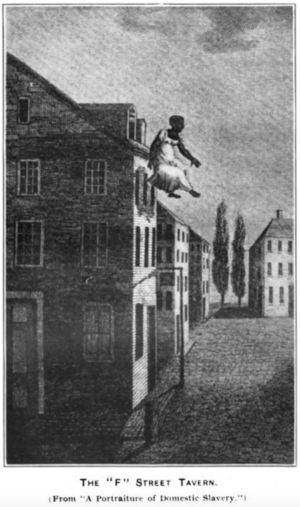Anna Williams (enslaved person) facts for kids
Anna "Ann" Williams (born around 1791 – died unknown) was an enslaved woman who bravely fought for her freedom. She successfully went to court to gain freedom for herself and her children. This happened at a high court in Washington, D.C., called the United States Court of Appeals for the DC Circuit. Her court case and her famous jump from a tavern window helped many people understand the terrible suffering caused by the slave trade.
Contents
Anna Williams' Life Story
Anna Williams was born into slavery around 1791 in Bladensburg, Maryland. She was forced to work on a plantation there. She was married and had six children.
A Difficult Sale and a Brave Jump
In November 1815, Anna was sold to slave traders from Georgia. This meant she was taken away from her family against her will. During this difficult time, she jumped from a third-floor window of the F Street Tavern in Washington, D.C.. This brave act became very well known. Writers who wanted to end slavery, called Abolitionists, shared her story. They used it to show the terrible ways enslaved people were treated. Anna broke her arms and back from the fall, but she survived. After her jump, the slave trader left Anna behind. However, he still took her two daughters away to be sold.
Help Arrives
News of Anna's jump reached Jesse Torrey. He was a doctor from Philadelphia and a writer who was against slavery. He was collecting real stories from African Americans about being enslaved or kidnapped. In December 1815, he visited Anna while she was still recovering at the tavern. He interviewed her to learn her story.
Anna's jump and the events around it led to an official government investigation in 1816. A congressman named John Randolph led this investigation. He officially asked Jesse Torrey, the two doctors who treated Anna, and lawyer Francis Scott Key to share what they knew. Francis Scott Key had been gathering proof of kidnappings related to the slave trade between different states.
Jesse Torrey also included Anna's story in his 1817 book, A Portraiture of Slavery in the United States. He did not use her real name in the book.
Fighting for Freedom in Court
In 1828, Anna Williams started a court case to gain her freedom. She claimed that George Miller Sr. and George Miller Jr. had enslaved her illegally. Her lawyer was Francis Scott Key. He convinced the court to let her live on her own while the case was decided.
In the summer of 1832, her case went to trial. On July 2, 1832, the jury decided that Anna was right. Anna won the case! This meant she, her children, and all their future descendants would be free. The jury likely decided that her sale in 1815 was against a Maryland law from 1796. This law said that slave traders could not bring slaves into Maryland just to sell them there.
Life After Freedom
In 1835, Anna Williams was interviewed again. She shared her story with Ethan Allen Andrews for his book, Slavery and the Domestic Slave Trade in the United States. By this time, she was living freely. She was reunited with her husband and living with four of her children. She was never reunited with her two daughters who had been sold illegally. She said she "always prays for them, and expects to meet them up there." Anna continued to have problems with walking throughout her later life, but she could still move around.
Anna Williams' Legacy
The story of Anna Williams is taught in history classes in middle and high schools across the United States.
Her story is also told in a 2018 animated short film called Anna: One woman's quest for freedom in early Washington, D.C.
See also
- List of slaves


